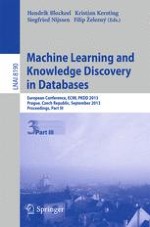This three-volume set LNAI 8188, 8189 and 8190 constitutes the refereed proceedings of the European Conference on Machine Learning and Knowledge Discovery in Databases, ECML PKDD 2013, held in Prague, Czech Republic, in September 2013. The 111 revised research papers presented together with 5 invited talks were carefully reviewed and selected from 447 submissions. The papers are organized in topical sections on reinforcement learning; Markov decision processes; active learning and optimization; learning from sequences; time series and spatio-temporal data; data streams; graphs and networks; social network analysis; natural language processing and information extraction; ranking and recommender systems; matrix and tensor analysis; structured output prediction, multi-label and multi-task learning; transfer learning; bayesian learning; graphical models; nearest-neighbor methods; ensembles; statistical learning; semi-supervised learning; unsupervised learning; subgroup discovery, outlier detection and anomaly detection; privacy and security; evaluation; applications; and medical applications.
